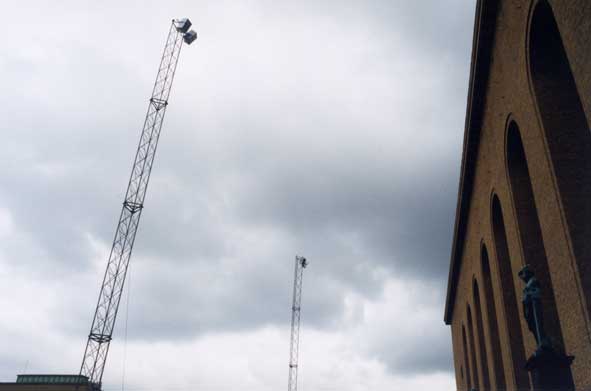Against All Evens: Goteborg Biennial 2003
2003-05-24 until 2003-08-31Goteborg Museum of Art
Gotenborg, , SE Sweden
Over the last ten years, there has been a crucial change on the international art scene: New York's dominance has been definitively broken, and the epicentre of the art world now oscillates between different locations on an almost daily basis. Major cities such as London, Paris, Frankfurt, Berlin and Vienna are still struggling over who will play the lead, but less talked-about places like Karlsruhe, Marseille, Newcastle, Bangkok, Montreal, Linz and Malmö put in regular appearances as well. Venice, Sao Paulo and Sydney have led the way with their biennials, inspiring many followers and creating a serious force for the spread of contemporary art.
Since 1990, significant international shows have appeared in Moss (Norway), Kwangju (South Korea), Santa Fe (USA), Dakar (Senegal), Yokohama (Japan), Taipei (Taiwan), Shanghai (China), Istanbul (Turkey), and Johannesburg (South Africa). It therefore seems only natural that a major manifestation of current international art be established in the Nordic countries - and more specifically, in Göteborg. Before the 1990s, the art establishment had no idea that there was interesting art outside of Europe, North America and Japan, but nowadays it is seen as strange if shows do not feature artists from countries such as Thailand, Mexico, or Benin. In that way at least, the world has opened up and become more accessible. Glocalism has become a fact.
For the 2nd Göteborg Biennial, I have invited 27 artists from Japan, Cambodia, Thailand, Libya, South Africa, USA, Mexico, Great Britain, Germany, Austria, Australia, Denmark, Finland, and Sweden. The title of the exhibition, Against All Evens, describes my thinkingbehind it and is really at the core of the show. It refers to a resistance against all that which is vapid, indifferent and toothless - to the mediocre. It seeks to engage, to elicit reactions and defiance - not, perhaps, based on confrontation, but rather from a critical standpoint. The artists at this biennial live up to this. With only a couple of exceptions, they have demonstrated strength through a refusal to compromise, a generous obstinacy, and persistence - over a period of years. There is no explicit or implicit homogeneity in terms of style, technique or concept; the common factor here is directness, reality. Fiction has taken a back seat. A number of the artists, including Pita, Hecker, Duncan, Pade, Niblock and Gordon, normally use sound as their main form of expression, but that is not to say that they will be using it at this particular exhibition. Others (Jürgenson, Stelarc, Janke and our solitary black sheep, Ekenberg) have science as their field, but that is not to say that they lack artistic ambitions or qualities. In Jürgenson's and Ekenberg's case, the elevation to 'artist' is my doing, and as in Margolles's work, the concept of death - sensitive territory for northern Europeans - is at the heart of their efforts. This is in direct contrast with Kusolwong's and Karlsson Rixon's positive, life-affirming work. So-called abstract art is also at the centre of the Biennial, with Nyström's, Pomassl's, Ikeda's and Grönlund/ Nisunen's work, but this involves a questioning of the 'abstract' notion using psycho-physical devices; they are works that invite the viewer's perceptivity to question non-figurative art. Fundamental principles play an important role in the work of all the above-mentioned artists. Through these principles they maintain, in one way or another, their wish for a pleasant life, without exploitation or negative application of their life and work. This could equally be said of the political poster art of Siala and Nath, of the realism and social criticism in photographs and installations by Geers, Haswell and Fredrikson, as well as of the nervous doubt that Höller will install, and which will permeate the exhibition as a whole.
It may be that apocalyptic and anxious voices have always been heard. They have certainly echoed throughout the 20th century - between the first and second world wars, during the wars in Korea and Vietnam, and during the cold war between the Warsaw Pact and NATO. The sense of impending doom, caused by the utter contempt of cynical powersthat-be and financial conglomerates for life-affirming values, has not lessened. Perhaps it has even increased. The world is run by a small number of mediocre people advised by blinkered careerists and wankers from the military and financial domains. It may be that we normal people can do nothing to change this; that it is pointless and even vain to try to do so. Perhaps the exhibition in Göteborg might contribute to a reaction of some kind - to a resistance. Against all those who are indifferent, despite all those who have had their fingers burned.
--Carl Michael von Hausswolff
Curator of the 2nd International Art Biennial in Göteborg
John Duncan presents a 4-channel outdoor audio installation heard from speakers mounted on two 24-meter high towers at the museum's main entrance. Audio composed by John Duncan, Voice components performed by the San Pietro Elementary School Choir, and conducted by John Duncan. Audio system designed by Giorgio Tomasini.
Photos © G. Stefani

